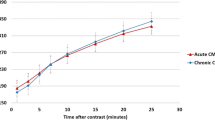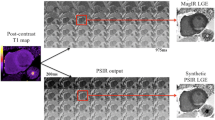Abstract
Purpose
To assess myocardial salvage in acute ST segment elevation myocardial infarction (STEMI) by using contrast-enhanced CMR.
Methods
Forty-four consecutive patients (38 male; mean age 59 ± 10 years) with a first acute STEMI underwent acute percutaneous coronary intervention with successful restoration of TIMI grade 3 flow. CMR was performed 2 ± 1 days after reperfusion on a standard 1.5 T MR Scanner that included a steady-state free precession cine imaging for LV function and an inversion-recovery fast low angle shot (TR 8 ms, TE 4 ms, FA 25°) sequences for late gadolinium enhancement (LGE) following the injection of 0.2 mmol/kg BW gadodiamide. The myocardium at risk (MR) was approximated by the volume of myocardium exhibiting LGE and/or impaired wall motion. The myocardial salvage index (MSI) was calculated as the volume of the MR minus the volume of LGE divided by the volume of the MR. Reperfusion therapy was rated successful with an ST elevation resolution (STR) ≥70% and was considered inadequate below 70%.
Results
Infarct size (LGE) was 17 ± 13% of LV mass, the mean STR was 53.4 ± 28.3%, and the MSI was 10.9 ± 6.2%. There was a good correlation between the MSI and the STR (r = 0.695, P < 0.0001). Thirty patients had an STR below 70%, and 14 patients had an STR greater than 70%. The MSI was greater in patients with a STE resolution of more than 70% (12 ± 11 vs. 6 ± 3%, P < 0.0001).
Conclusion
A simple MR algorithm based upon the relationship of functional impairment, which includes myocardial stunning, to the extent of LGE (infarct necrosis) is in accordance with STR as a clinical marker of successful reperfusion in acute myocardial infarction.


Similar content being viewed by others
References
Reimer KA, Lowe JE, Rasmussen MM, Jennings RB (1977) The wavefront phenomenon of ischemic cell death. 1. Myocardial infarct size vs duration of coronary occlusion in dogs. Circulation 56:786–794
Antman EM, Anbe DT, Armstrong PW et al (2004) ACC/AHA guidelines for the management of patients with ST-elevation myocardial infarction: a report of the American College of Cardiology/American Heart Association Task Force on Practice Guidelines (Committee to Revise the 1999 Guidelines for the Management of Patients with Acute Myocardial Infarction). Circulation 110:e82–e292
Andersen HR, Nielsen TT, Rasmussen K et al (2003) A comparison of coronary angioplasty with fibrinolytic therapy in acute myocardial infarction. N Engl J Med 349:733–742
Boersma E (2006) Does time matter? A pooled analysis of randomized clinical trials comparing primary percutaneous coronary intervention and in-hospital fibrinolysis in acute myocardial infarction patients. Eur Heart J 27:779–788
Keeley EC, Boura JA, Grines CL (2003) Primary angioplasty versus intravenous thrombolytic therapy for acute myocardial infarction: a quantitative review of 23 randomised trials. Lancet 361:13–20
Khattab AA, Abdel-Wahab M, Rother C et al (2008) Multi-vessel stenting during primary percutaneous coronary intervention for acute myocardial infarction. A single-center experience. Clin Res Cardiol 97:32–38
Wagner A, Mahrholdt H, Holly TA et al (2003) Contrast-enhanced MRI and routine single photon emission computed tomography (SPECT) perfusion imaging for detection of subendocardial myocardial infarcts: an imaging study. Lancet 361:374–379
Kim RJ, Wu E, Rafael A et al (2000) The use of contrast-enhanced magnetic resonance imaging to identify reversible myocardial dysfunction. N Engl J Med 343:1445–1453
Kim RJ, Fieno DS, Parrish TB et al (1999) Relationship of MRI delayed contrast enhancement to irreversible injury, infarct age, and contractile function. Circulation 100:1992–2002
Steen H, Nasir K, Flynn E et al (2007) Is magnetic resonance imaging the ‘reference standard’ for cardiac functional assessment? Factors influencing measurement of left ventricular mass and volumes. Clin Res Cardiol 96:743–751
Kurz K, Schild C, Isfort P, Katus HA, Giannitsis E (2009) Serial and single time-point measurements of cardiac troponin T for prediction of clinical outcomes in patients with acute ST-segment elevation myocardial infarction. Clin Res Cardiol 98:94–100
Hombach V, Merkle N, Kestler HA et al (2008) Characterization of patients with acute chest pain using cardiac magnetic resonance imaging. Clin Res Cardiol 97:760–767
van’t Hof AW, Liem A, de Boer MJ, Zijlstra F (1997) Clinical value of 12-lead electrocardiogram after successful reperfusion therapy for acute myocardial infarction. Zwolle Myocardial infarction Study Group. Lancet 350:615–619
de Lemos JA, Antman EM, Giugliano RP et al (2000) ST-segment resolution and infarct-related artery patency and flow after thrombolytic therapy. Thrombolysis in Myocardial Infarction (TIMI) 14 investigators. Am J Cardiol 85:299–304
Schroder R (2004) Prognostic impact of early ST-segment resolution in acute ST-elevation myocardial infarction. Circulation 110:e506–e510
Schroder R, Dissmann R, Bruggemann T et al (1994) Extent of early ST segment elevation resolution: a simple but strong predictor of outcome in patients with acute myocardial infarction. J Am Coll Cardiol 24:384–391
Barbash GI, Roth A, Hod H et al (1990) Rapid resolution of ST elevation and prediction of clinical outcome in patients undergoing thrombolysis with alteplase (recombinant tissue-type plasminogen activator): results of the Israeli Study of Early Intervention in Myocardial Infarction. Br Heart J 64:241–247
Clemmensen P, Ohman EM, Sevilla DC et al (1990) Changes in standard electrocardiographic ST-segment elevation predictive of successful reperfusion in acute myocardial infarction. Am J Cardiol 66:1407–1411
Dong J, Ndrepepa G, Schmitt C et al (2002) Early resolution of ST-segment elevation correlates with myocardial salvage assessed by Tc-99m sestamibi scintigraphy in patients with acute myocardial infarction after mechanical or thrombolytic reperfusion therapy. Circulation 105:2946–2949
Wu KC (2009) Fighting the “fire” of myocardial reperfusion injury: how to define success? J Am Coll Cardiol 53:730–731
Atar D, Petzelbauer P, Schwitter J et al (2009) Effect of intravenous FX06 as an adjunct to primary percutaneous coronary intervention for acute ST-segment elevation myocardial infarction results of the F.I.R.E. (Efficacy of FX06 in the Prevention of Myocardial Reperfusion Injury) trial. J Am Coll Cardiol 53:720–729
Mahrholdt H, Wagner A, Holly TA et al (2002) Reproducibility of chronic infarct size measurement by contrast-enhanced magnetic resonance imaging. Circulation 106:2322–2327
Milavetz JJ, Giebel DW, Christian TF, Schwartz RS, Holmes DR Jr, Gibbons RJ (1998) Time to therapy and salvage in myocardial infarction. J Am Coll Cardiol 31:1246–1251
Kastrati A, Mehilli J, Dirschinger J et al (2002) Myocardial salvage after coronary stenting plus abciximab versus fibrinolysis plus abciximab in patients with acute myocardial infarction: a randomised trial. Lancet 359:920–925
Verani MS, Jeroudi MO, Mahmarian JJ et al (1988) Quantification of myocardial infarction during coronary occlusion and myocardial salvage after reperfusion using cardiac imaging with technetium-99m hexakis 2-methoxyisobutyl isonitrile. J Am Coll Cardiol 12:1573–1581
Meyborg P, Abdel-Wahab M, Herrmann G et al (2007) Relationship between therapeutic time intervals and intermediate term left ventricular systolic function in patients treated with facilitated percutaneous coronary intervention for acute myocardial infarction. Clin Res Cardiol 96:94–102
Friedrich MG, Abdel-Aty H, Taylor A, Schulz-Menger J, Messroghli D, Dietz R (2008) The salvaged area at risk in reperfused acute myocardial infarction as visualized by cardiovascular magnetic resonance. J Am Coll Cardiol 51:1581–1587
Aletras AH, Tilak GS, Natanzon A et al (2006) Retrospective determination of the area at risk for reperfused acute myocardial infarction with T2-weighted cardiac magnetic resonance imaging: histopathological and displacement encoding with stimulated echoes (DENSE) functional validations. Circulation 113:1865–1870
Simonetti OP, Kim RJ, Fieno DS et al (2001) An improved MR imaging technique for the visualization of myocardial infarction. Radiology 218:215–223
Braunwald E, Kloner RA (1982) The stunned myocardium: prolonged, postischemic ventricular dysfunction. Circulation 66:1146–1149
Author information
Authors and Affiliations
Corresponding author
Rights and permissions
About this article
Cite this article
Jensen, C.J., Bleckmann, D., Eberle, H.C. et al. A simple MR algorithm for estimation of myocardial salvage following acute ST segment elevation myocardial infarction. Clin Res Cardiol 98, 651–656 (2009). https://doi.org/10.1007/s00392-009-0051-z
Received:
Accepted:
Published:
Issue Date:
DOI: https://doi.org/10.1007/s00392-009-0051-z




